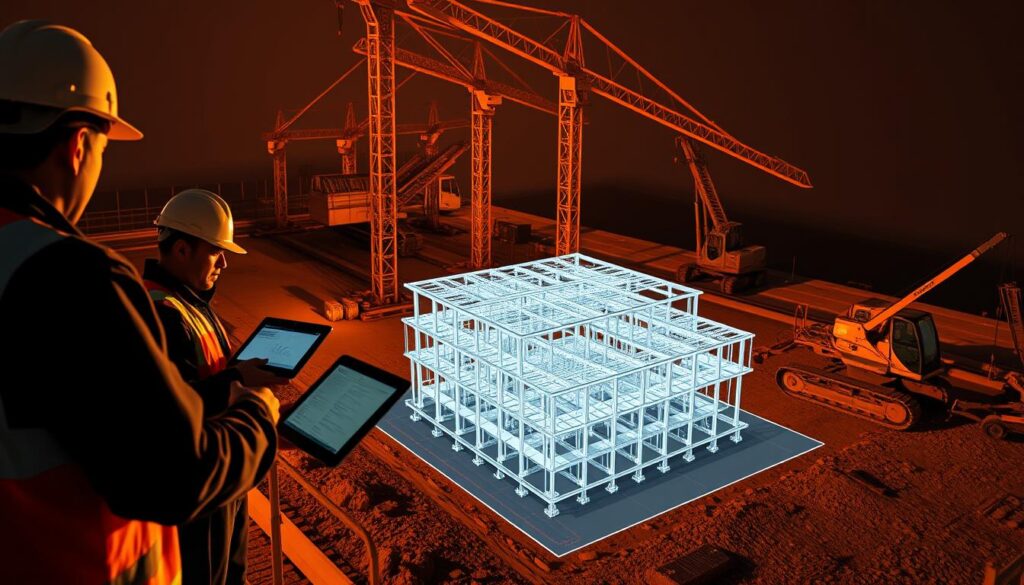Are you curious about how BIM technology is transforming the construction industry?
The adoption of Building Information Modeling is revolutionizing the field of civil engineering by enhancing project delivery, collaboration, and overall efficiency.
For civil engineers, the benefits of BIM are numerous, ranging from improved project visualization to enhanced data management.
Key Takeaways
- Improved project delivery through enhanced collaboration
- Enhanced data management for better decision-making
- Increased efficiency in project execution
- Better project visualization through detailed modeling
- Reduced errors and improved quality control
Understanding Building Information Modeling (BIM)
BIM is more than just a technological advancement; it’s a paradigm shift for civil engineers. By integrating various aspects of a project into a single, coherent model, BIM enables a more holistic understanding and management of project data.
What is BIM?
Building Information Modeling (BIM) is a digital representation of the physical and functional characteristics of a project. It’s a comprehensive process that involves creating and managing information throughout the project lifecycle.
The BIM technology benefits in civil engineering are multifaceted, enhancing collaboration, reducing errors, and improving project visualization.
Key Components of BIM
The key components of BIM include:
- 3D modeling
- Data-rich objects
- Project information management
- Collaboration tools
These components work together to provide a comprehensive understanding of a project, highlighting the significance of BIM for civil infrastructure.
| BIM Component | Description | Benefit |
|---|---|---|
| 3D Modeling | Visual representation of the project | Enhanced project visualization |
| Data-rich Objects | Objects containing detailed project data | Improved data management |
| Project Information Management | Centralized management of project information | Streamlined collaboration |
How BIM Works
BIM works by creating a digital model that is rich in data, allowing for real-time collaboration and information sharing among stakeholders. This process leverages the significance of BIM for civil infrastructure by enhancing project outcomes through better planning, execution, and management.
Enhanced Collaboration Among Teams
Collaboration is key to successful project delivery, and BIM facilitates this by breaking down silos among teams. By leveraging BIM, civil engineers can ensure that all stakeholders are on the same page, working towards a common goal.
Breaking Down Silos
BIM encourages a culture of collaboration by providing a shared platform for data exchange and project visualization. This helps in reducing misunderstandings and miscommunications that often lead to project delays.
The integration of BIM tools enables teams to work more cohesively, ensuring that architectural, engineering, and construction teams are aligned throughout the project lifecycle.

Encouraging Multidisciplinary Input
BIM is not just a tool for civil engineers; it’s a platform that encourages input from various disciplines involved in a project. This multidisciplinary approach ensures that all aspects of a project are considered, leading to more comprehensive and sustainable designs.
| Benefits of BIM Collaboration | Description |
|---|---|
| Improved Communication | Enhances data sharing and reduces errors |
| Increased Transparency | Provides real-time updates on project status |
| Better Decision Making | Facilitates informed decisions through data analysis |
By adopting BIM, civil engineers can significantly enhance collaboration among teams, leading to more efficient and effective project outcomes.
Improved Project Visualization
BIM technology offers civil engineers a powerful tool for enhancing project visualization through detailed 3D models. This capability is crucial for the importance of BIM in civil engineering design, as it allows for a more comprehensive understanding of the project.
The use of 3D modeling in BIM brings numerous benefits to civil construction projects. It enables engineers to identify potential issues early on, reducing the likelihood of costly rework during the construction phase. As Autodesk, a leading provider of BIM software, notes, “3D modeling allows for a more accurate representation of the project, improving communication among stakeholders.”
3D Modeling Benefits
The benefits of 3D modeling in civil engineering are multifaceted. It enhances the visualization of complex structures, allowing for better planning and execution. Some of the key advantages include:
- Improved accuracy in project representation
- Enhanced collaboration among project teams
- Better identification of potential design issues
According to a study, the use of BIM for 3D modeling can lead to significant cost savings by reducing errors and minimizing rework. “BIM has the potential to save the construction industry billions of dollars annually,” as quoted by a leading industry expert.
Simulations and Real-time Views
BIM also enables the creation of simulations and real-time views, further enhancing project visualization. This capability is particularly beneficial for benefits of using BIM for civil construction projects, as it allows for real-time monitoring and adjustments.
Simulations can be used to analyze various aspects of the project, such as structural integrity and environmental impact. Real-time views, on the other hand, provide stakeholders with an up-to-date understanding of the project’s progress.
By leveraging these features, civil engineers can ensure that projects are executed more efficiently, with fewer delays and cost overruns. As the industry continues to adopt BIM technology, the benefits of improved project visualization will become increasingly evident.
Increased Accuracy and Precision
With the advent of BIM, civil engineers can now undertake projects with a level of accuracy and precision that was previously unattainable. This significant advancement is largely due to the sophisticated tools and methodologies that BIM brings to the table.
BIM’s impact on accuracy and precision can be seen in several areas, most notably in error reduction and cost estimation. By leveraging BIM’s capabilities, civil engineers can minimize mistakes and improve project outcomes.
Error Reduction Techniques
One of the primary advantages of BIM is its ability to reduce errors through advanced modeling and simulation. BIM software allows for the creation of detailed, data-rich models that can be used to identify potential issues before they become major problems.
- Clash detection: Identifying conflicts between different building systems.
- Design validation: Ensuring that the design meets the specified requirements.
- Constructability analysis: Analyzing the feasibility of the construction process.
By utilizing these error reduction techniques, civil engineers can significantly improve the accuracy of their projects, leading to better overall quality and reduced rework.

Cost Estimation Precision
BIM also enhances cost estimation precision by providing a detailed and accurate basis for cost calculations. The data-rich models created through BIM can be used to generate precise quantity takeoffs and cost estimates.
| Cost Estimation Feature | BIM Advantage |
|---|---|
| Quantity Takeoffs | Accurate material quantities reduce cost estimation errors. |
| Cost Databases | Integration with cost databases ensures up-to-date pricing. |
| Real-time Updates | Changes to the model are reflected in real-time cost estimates. |
As
“BIM has transformed the way we approach construction projects, enabling us to deliver more accurate and precise outcomes.”
This quote highlights the transformative impact of BIM on the construction industry, particularly in terms of accuracy and precision.
By integrating BIM into their workflows, civil engineers can reap the benefits of improved accuracy and precision, ultimately leading to more successful project outcomes.
Streamlined Project Management
BIM technology is revolutionizing project management in civil engineering by providing a more streamlined, efficient, and transparent process. By leveraging BIM, project managers can better coordinate tasks, manage timelines, and allocate resources more effectively.
Scheduling and Time Management
One of the significant benefits of BIM for civil engineering projects is its ability to enhance scheduling and time management. BIM tools allow for the creation of detailed project schedules and timelines, enabling project managers to identify potential delays and take corrective actions proactively.
Moreover, BIM facilitates real-time collaboration and data sharing among team members, ensuring that everyone is on the same page regarding project timelines and milestones. This real-time visibility into project progress helps in making informed decisions and adjusting project schedules as needed.
Task Assignment Transparency
BIM also brings about task assignment transparency by providing a clear overview of task allocations and responsibilities. Through BIM platforms, project managers can assign tasks to team members and track progress, ensuring that all stakeholders have a unified understanding of project status and requirements.
This transparency not only improves team collaboration but also reduces misunderstandings and miscommunications that can lead to project delays. By utilizing BIM for task management, civil engineering projects can achieve a higher level of operational efficiency and productivity.
In conclusion, the integration of BIM in civil engineering projects significantly enhances project management by streamlining scheduling, improving time management, and ensuring task assignment transparency. These benefits of BIM contribute to the overall success and efficiency of civil engineering projects.
Effective Risk Management
BIM technology benefits in civil engineering extend to effective risk management, a critical aspect of project success. Civil engineering projects are complex and involve numerous risks, including design flaws, construction errors, and unforeseen site conditions.
Effective risk management is crucial to mitigate these risks and ensure project success. BIM technology facilitates this process by enabling the early detection of potential issues and mitigating design risks.
Identifying Potential Issues Early
One of the key benefits of BIM is its ability to identify potential issues early in the project lifecycle. By creating a digital twin of the project, engineers can simulate various scenarios, detect clashes, and analyze the constructability of the design.
This proactive approach enables project teams to address potential problems before they become major issues, reducing the likelihood of costly rework and delays. For instance, BIM can help identify potential structural weaknesses, allowing engineers to make necessary adjustments to the design.

Mitigating Design Risks
BIM also plays a critical role in mitigating design risks. By using BIM software, engineers can create detailed 3D models that help to identify potential design flaws and errors.
This enables project teams to refine the design, ensuring that it is accurate, complete, and constructible. Moreover, BIM facilitates collaboration among stakeholders, ensuring that everyone is on the same page and that design changes are properly coordinated.
By leveraging BIM technology, civil engineers can minimize design risks, reduce the likelihood of costly rework, and ensure that projects are completed on time and within budget.
Cost Savings Throughout the Project Lifecycle
BIM technology offers civil engineers a powerful tool for achieving cost savings across various stages of a project. By enhancing the precision of budgeting and reducing long-term maintenance costs, BIM significantly impacts the overall financial management of civil infrastructure projects.
Budgeting with BIM
Effective budgeting is crucial in the initial phases of any civil engineering project. BIM facilitates accurate cost estimation by providing detailed models that account for all materials and labor required. This precision helps in avoiding cost overruns by identifying potential expenses early on.
The use of BIM tools enables project managers to create detailed financial plans and forecasts. By integrating cost data into the BIM model, teams can analyze different scenarios and make informed decisions that optimize budget allocation.
Long-term Maintenance Cost Benefits
Beyond the initial construction phase, BIM continues to offer cost-saving benefits through its ability to enhance the management of infrastructure assets. By creating a digital twin of the project, BIM allows for real-time monitoring and maintenance scheduling, reducing the likelihood of costly repairs and extending the lifespan of infrastructure.
Long-term maintenance costs are significantly reduced as BIM provides a comprehensive database of the infrastructure’s components, facilitating proactive maintenance and minimizing downtime. This not only saves costs but also ensures the infrastructure remains operational and efficient over its lifecycle.
The significance of BIM for civil infrastructure lies in its ability to deliver cost savings throughout the project lifecycle, from initial budgeting to long-term maintenance. By leveraging BIM, civil engineers can ensure that projects are not only completed on time and within budget but also remain cost-effective over their operational lifespan.
Sustainability and Energy Efficiency
Civil engineers are leveraging BIM to significantly improve the sustainability and energy efficiency of their projects. By utilizing BIM technology, engineers can analyze and optimize various aspects of a project to minimize its environmental footprint.
Environmental Impact Analysis
BIM enables the creation of detailed models that can be used to analyze the environmental impact of a project. This includes assessing the effects of different materials, energy consumption patterns, and waste management strategies.
Key benefits of environmental impact analysis with BIM include:
- Reduced material waste through optimized design
- Lower energy consumption through efficient systems
- Improved sustainability through the selection of eco-friendly materials

Optimizing Energy Use
Optimizing energy use is a critical aspect of sustainable project design. BIM allows engineers to simulate various energy consumption scenarios, enabling them to identify the most energy-efficient solutions.
| Energy Efficiency Measure | Description | Potential Savings |
|---|---|---|
| Building Orientation | Optimizing the building’s orientation to maximize natural light and reduce heating/cooling needs | Up to 15% |
| Insulation and Glazing | Improving insulation and glazing to reduce heat loss and gain | Up to 20% |
| Renewable Energy Systems | Integrating renewable energy systems, such as solar or wind power | Up to 50% |
By analyzing environmental impact and optimizing energy use, BIM contributes to more sustainable and energy-efficient infrastructure projects. This not only benefits the environment but also reduces operational costs over the project’s lifecycle.
Simplified Regulatory Compliance
The integration of BIM into civil engineering projects is simplifying the complex task of meeting regulatory requirements. By leveraging the detailed digital models created through BIM, engineers can more easily ensure that their projects comply with local building codes and regulations.
Meeting Local Building Codes
BIM enhances the ability to meet local building codes by providing a comprehensive digital representation of the project. This includes detailed information about the building’s design, materials, and systems, making it easier to verify compliance with specific code requirements.
Key Benefits of BIM for Code Compliance:
- Automated code checking
- Enhanced accuracy in design and documentation
- Improved collaboration among stakeholders
Easing Permitting Processes
BIM also streamlines the permitting process by providing authorities with the detailed information they need to review and approve projects efficiently. This can significantly reduce the time and effort required to obtain necessary permits.
| Permitting Process Aspect | Traditional Method | BIM-Enhanced Method |
|---|---|---|
| Submission Requirements | Manual preparation of documents | Automated generation of necessary documents |
| Review Process | Manual review by authorities | Automated code checking and validation |
| Approval Timeframe | Several weeks or months | Significantly reduced, often within days |
By simplifying regulatory compliance, BIM not only reduces the administrative burden on civil engineers but also helps ensure that projects are completed on time and within budget. As the construction industry continues to evolve, the role of BIM in facilitating compliance with regulatory requirements is likely to become even more critical.
Enhanced Communication with Stakeholders
Building Information Modeling (BIM) has revolutionized the way civil engineers communicate with stakeholders by providing a more transparent and interactive project environment. This enhancement in communication is crucial for project success, as it ensures that all stakeholders are aligned with the project’s progress and goals.

Client Engagement through Visualization
One of the key benefits of BIM is its ability to facilitate client engagement through advanced visualization techniques. By creating detailed 3D models, civil engineers can provide stakeholders with a clear understanding of the project’s design and progress. This visualization helps in identifying potential issues early on, reducing misunderstandings, and ensuring that the project meets the client’s expectations.
- Improved understanding of project designs through 3D visualization
- Enhanced collaboration among stakeholders
- Better identification of potential issues
Regular Updates and Reports
BIM also enables civil engineers to provide regular updates and reports to stakeholders, keeping them informed about the project’s status. This transparency is achieved through the use of BIM software that can generate detailed reports and updates, ensuring that stakeholders are always aware of the project’s progress.
The importance of BIM in civil engineering design is evident in its ability to enhance stakeholder communication. By leveraging BIM, civil engineers can ensure that projects are completed on time, within budget, and to the satisfaction of all stakeholders.
Key benefits of BIM in stakeholder communication include:
- Enhanced client engagement through visualization
- Regular and transparent project updates
- Improved collaboration among project teams
Integration with Other Technologies
One of the key benefits of using BIM for civil construction projects is its ability to integrate with other technologies, such as design software and IoT devices. This integration enhances the capabilities of BIM, allowing for more comprehensive and accurate project outcomes.
The compatibility of BIM with various design software is a significant advantage. It enables civil engineers to seamlessly transfer data between different platforms, reducing errors and improving collaboration. For instance, BIM can be integrated with computer-aided design (CAD) software, allowing for the creation of detailed 3D models that can be used for simulations and analysis.
Compatibility with Design Software
BIM’s compatibility with design software is crucial for enhancing the design process. By integrating BIM with CAD software, engineers can create precise models that include detailed information about the project’s components. This integration facilitates the identification of potential design issues early on, reducing the need for costly revisions later in the project.
Autodesk Revit is a popular example of BIM software that integrates well with various design tools, enabling the creation of comprehensive project models. The integration of BIM with design software also enhances the visualization of the project, allowing stakeholders to better understand the project’s scope and timeline.
Utilizing IoT with BIM
The integration of BIM with the Internet of Things (IoT) is another significant advancement in the field of civil engineering. IoT devices can be used to collect real-time data from the construction site, which can then be integrated with the BIM model. This integration enables real-time monitoring of the project’s progress, allowing for more efficient project management.
For example, IoT sensors can be used to track the condition of construction equipment, monitor environmental conditions, and detect potential safety hazards. This data can be fed into the BIM model, providing a comprehensive view of the project’s status and enabling data-driven decision-making.
- Enhanced project monitoring through real-time data collection
- Improved safety through the detection of potential hazards
- Increased efficiency through data-driven decision-making
By leveraging the integration of BIM with IoT and design software, civil engineers can unlock new levels of project efficiency, accuracy, and collaboration. This integration is a key factor in the successful implementation of BIM in civil construction projects.
Case Studies Highlighting BIM Success
Case studies from around the world highlight the advantages of integrating BIM for civil engineering planning, demonstrating its potential in achieving project goals.
Real-world Applications
BIM has been successfully applied in various civil engineering projects, including infrastructure development and building construction. For instance, the use of BIM in the London Crossrail project enabled the project team to manage complex tunnel alignments and detect potential clashes early on.
Another example is the Miami Bridge Reconstruction, where BIM facilitated the design and construction of a new bridge, minimizing disruptions to traffic and ensuring timely completion.

Lessons Learned from Successful Projects
Several key lessons have emerged from successful BIM implementations:
- Early adoption of BIM is crucial for maximizing its benefits.
- Collaboration among stakeholders is enhanced through the use of a common data environment.
- Continuous training and upskilling of personnel are necessary to fully leverage BIM capabilities.
These lessons underscore the importance of a well-planned BIM strategy in civil engineering projects.
By examining these case studies, civil engineers and project managers can gain valuable insights into the effective application of BIM, ultimately leading to improved project outcomes.
Trends Shaping the Future of BIM
Emerging trends and technologies are redefining the role of BIM in civil engineering, offering new opportunities and challenges. As the industry continues to evolve, it’s essential to understand the innovations and future challenges that will shape the BIM landscape.
Innovations in the Industry
The BIM industry is witnessing significant innovations, including the integration of Artificial Intelligence (AI) and Machine Learning (ML) to enhance data analysis and project forecasting. Another key trend is the adoption of Cloud-based BIM, which facilitates real-time collaboration and data sharing across different stakeholders.
The use of Virtual Reality (VR) and Augmented Reality (AR) is also becoming more prevalent, allowing for immersive project visualization and enhanced client engagement. These technologies are not only improving project outcomes but also streamlining processes, making them more efficient and cost-effective.
Future Challenges and Opportunities
Despite the advancements, the BIM industry faces several challenges, including data security concerns and the need for standardized protocols. However, these challenges also present opportunities for growth and innovation. For instance, addressing data security can lead to the development of more robust cybersecurity measures, while standardization can facilitate smoother collaboration across different platforms.
The future of BIM is also closely tied to the concept of smart infrastructure, where buildings and infrastructure are designed to be more sustainable, efficient, and responsive to the needs of occupants. This involves integrating BIM with Internet of Things (IoT) technologies to create dynamic, data-driven environments.
| Trend | Description | Impact on BIM |
|---|---|---|
| AI and ML Integration | Enhancing data analysis and project forecasting | Improved project planning and execution |
| Cloud-based BIM | Facilitating real-time collaboration and data sharing | Enhanced team collaboration and data accessibility |
| VR and AR Adoption | Immersive project visualization and client engagement | Better client understanding and project visualization |
By understanding these trends and preparing for the challenges ahead, civil engineers can harness the full potential of BIM to drive innovation and success in their projects.
Conclusion: Embracing BIM for Civil Engineering Success
The adoption of Building Information Modeling (BIM) is transforming the civil engineering landscape by offering numerous benefits, including enhanced collaboration, improved project visualization, and cost savings. As civil engineers continue to navigate complex projects, leveraging BIM technology is crucial for achieving success.
Advancing Civil Engineering with BIM
The benefits of BIM for civil engineering projects are multifaceted. By utilizing BIM, engineers can create detailed digital models that facilitate better project planning, execution, and maintenance. This leads to improved accuracy, reduced errors, and enhanced sustainability.
Future-Proofing Civil Engineering Projects
As the industry continues to evolve, the BIM technology benefits in civil engineering will only continue to grow. By embracing BIM, civil engineers can stay ahead of the curve, delivering projects that are not only efficient and cost-effective but also environmentally friendly. The future of civil engineering is closely tied to the adoption of BIM, making it an essential tool for professionals in this field.
